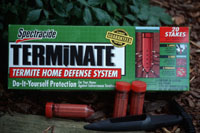Do-It-Yourself Termite Baits: Do They Work?
ENTFACT-642: Do-It-Yourself Termite Baits - Do They Work? | Download PDF
by Michael F. Potter, Extension Entomologist
University of Kentucky College of Agriculture
The Entomology Department at the University of Kentucky receives many inquiries about a "do-it-yourself" termite control product sold in retail stores throughout the United States.

Terminate Box
The Terminate™ Termite Home Defense System is being marketed under the Spectracide brand of lawn and garden insecticides. The question homeowners are asking is: "Does the product work?"
Terminate's retail price—under $100 for a box of bait stakes—is tempting, given that a professional termite treatment may cost well over $1000. However, there are issues with this product that should be considered in the purchasing decision.
Product Description
Traditional termite treatments afford structural protection by creating a persistent chemical barrier in the soil. Termites attempting to penetrate the treated soil are either killed or repelled, and the remainder of the population are forced to find food elsewhere. Spectracide Terminate™ is an entirely different concept. Formulated as a bait, the product is meant to be eaten by termites foraging below ground in the vicinity of the structure. Professional pest control firms have been using other termite baits, such as the Sentricon™ Colony Elimination System, for a number of years with favorable results (See ENTFACT-639, Termite Baits: A Guide for Homeowners). Research and practical experience with the professionally-installed baits indicates that they require careful installation, diligent monitoring, and ongoing surveillance by a trained individual. Furthermore, not all termite baiting systems are equally effective. Some products have had difficulty eliminating termite infestations within structures and have required supplemental treatment with liquid termiticides. This also will be true of Terminate™.
The active ingredient in Terminate (sulfluramid) is incorporated into a small roll of corrugated cardboard, housed within a red, transparent plastic tube or “stake.” Bait stakes are 4 inches long by 1 inch in diameter, with holes drilled in the sides for termites to enter and exit. After termites have fed upon the bait, they exit the stakes and rejoin with their nest mates in the soil. Because the bait material kills termites rather slowly (about 3 to 14 days after feeding), some transfer of the toxicant occurs to other colony members, including those that never fed on the bait. Termites cannot see or smell the baits from any appreciable distance underground; they encounter them largely by chance during their below-ground foraging activities.
Spectracide Terminate™ is sold in quantities of 20, 40, or 60 stakes per box, depending on the size (square footage) of the structure. All except the smallest single family homes will require purchase of the larger-size boxes at an incrementally higher cost.
Directions for Use
Package directions specify that bait stakes be inserted into holes drilled in the ground around the perimeter of the home, about 10 feet apart and within 2-3 feet of the foundation. Additional stakes are installed in “critical areas” suspected to contain termites, such as moist areas around mulch beds, water spigots, down spouts or sprinklers. Following installation, the stakes must be inspected by the homeowner every 2 to 3 months by pulling them from the ground and observing whether the bait has been eaten, or if termites are present inside. Additional stakes are added within 1 foot of any that show evidence of termites. The instructions further state that after activity has ceased, the stakes should continue to be monitored at least every 3 months for an additional 9 months. Stakes should be replaced before termites consume all of the bait, and must be replaced or removed every 9 months.
Product Claims
Terminate's advertising claims could be misinterpreted by many consumers. As part of a 1999 settlement with the Federal Trade Commission and several state attorneys general (including Kentucky), product directions now state that Terminate is not recommended as a sole protection against termites, and for active infestations the buyer is advised to get an inspectionand treatment by a professional. Despite the labeling changes, many homeowners purchasing the product may still think that their home is being protected from termite attack—an assumption not yet proven by published research data, especially when the bait is installed and maintained by homeowners rather than professionals.
The warranty statement guarantees that the product will protect your home from subterranean termite attack for 12 months from the date of purchase. Yet most customers will have difficulty knowing whether their home is truly being "protected" while the warranty is in effect. Termites tend to be cryptic in their foraging and feeding habits; feeding on Terminate™ stakes out in the yard is no assurance that termites are not also feasting on the structure.
Successful termite baiting requires diligent installation, monitoring and bait replenishment, and ongoing surveillance of the structure. Supplemental treatment with liquid termiticides may also be required. For these and other reasons, we believe that baiting is a job best left to professionals.
Revised: 3/04
CAUTION! Pesticide recommendations in this publication are registered for use in Kentucky, USA ONLY! The use of some products may not be legal in your state or country. Please check with your local county agent or regulatory official before using any pesticide mentioned in this publication.
Of course, ALWAYS READ AND FOLLOW LABEL DIRECTIONS FOR SAFE USE OF ANY PESTICIDE!
Photos courtesy of M.F. Potter, University of Kentucky Entomology. Please note that all photos in this publication are copyrighted material and may not be copied or downloaded without permission of the author.
